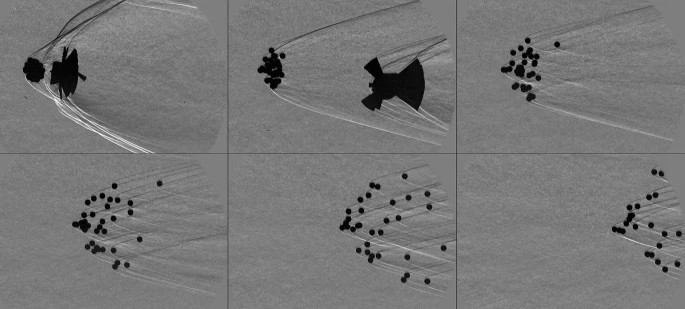Research Projects
Our research focuses on a variety of problems in high-speed flow, including hypersonic turbulence transition, shock-wave boundary-layer interactions, fluid-structure interactions, scramjet unstart phenomena, and meteorics.
Boundary-Layer Transition
Transition to turbulence of the boundary layers on a hypersonic vehicle can lead to highly elevated surface heating as well as enhanced frictional drag; understanding the transition process is thus vitally important for the design of such vehicles. On slender axisymmetric or planar bodies, the dominant boundary-layer instability mechanism at hypersonic speeds is typically what is known as the second or Mack mode, which may be thought of as acoustic waves that become trapped within the boundary layer. Studies of the second mode are made difficult by the high frequencies involved - typically several hundreds of kHz. Experimental investigations have shown that it is possible to visualize second-mode wave packets using high-speed schlieren images (see below) and derive valuable information regarding the propagation and breakdown characteristics of these disturbances. Our recent work at the Air Force's AEDC Tunnel 9 explores optical and pressure measurements of boundary-layer transition at Mach 10 and 14.

High-Altitude Flow-Disturbance Measurements
One of the major uncertainties in predicting the location of boundary-layer transition on hypersonic flight vehicles is associated with our lack of knowledge of the flow-disturbance environment in which they will operate (100+ kft). The relevant disturbances have length scales of the order of millimeters or centimeters, several orders of magnitude smaller than those typically of interest to atmospheric sciences. We have developed a high-fidelity balloon-borne measurement platform, FiSH (Fluctuations in the Stratosphere using Hot-wires), to characterize the various flow-disturbance modalities encountered in the mid-stratosphere. Work is currently underway to further enhance our measurement capabilities (through development of a high-altitude calibration tunnel) and extend our measurements to zero-pressure balloons.

Shock-Wave Boundary-Layer Interactions
Shock-wave boundary-layer interactions are a complex flow phenomenon occuring in both external and internal supersonic flows. Shock-induced separation of turbulent boundary-layers causes a recirculation region that can result in highly unsteady flow features, dramatically increased thermal loading, and coupling of low-frequency pressure oscillations to vehicle structural modes. While the exact mechanism giving rise to the low-frequency unsteadiness has yet to be identified, experimental and computational efforts have made progress to determine that upstream flowfield features are better correlated to shock motion than is the inflow boundary-layer. We are conducting experiments in a compression corner configuration to investigate both the dominant flow mechanisms and the intense fluid-structure interactions that can develop.

Supersonic Combustion and Propulsion
Scramjets (supersonic combustion ramjets) are a theoretically attractive alternative to rockets for high-speed powered flight. There are numerous challenges, however, associated with bringing a practical scramjet-powered aircraft into operation. One important factor that can restrict scramjet design is engine unstart, i.e., the disgorging of the inlet shock system. Recent studies have investigated the combustor behavior associated with the onset of unstart in a generic scramjet engine. Detailed observations of the formation and propagation of the choking shock train (see below images) has provided a much improved understanding of the linked fluid-combustor phenomena involved, and have shown that it may be possible to stabilize the shock train downstream of injection, leading to increased combustion efficiency and combustor performance.

Free-Flight Aerodynamics
HAPL researchers have pioneered the use of advanced free-flight techniques for studying high-speed aerodynamic problems. We have developed highly accurate optical-tracking techniques, capable of tracking 6 DoF motions of aribitrary bodies to micron-level precision, and have applied these techniques in studying the separation dynamics of multiple bodies in hypersonic flows. Such investigations are critical to understanding, for example, meteoroid fragmentation, destructive re-entry, and high-speed store and stage separation.

High-Speed Multi-Phase Flows
Hypersonic projectiles launched at low altitudes may encounter liquid droplets when traveling through clouds or precipitation along their flight paths; while vehicles traveling at higher altitudes will avoid such environments, aerosols on the order of microns are still likely to present. Deepening our understanding of the interactions between hypersonic flowfields and liquid/solid particulates is the objective of a MURI award that was recently awarded to a team, led by the University of Minnesota, of which HAPL is a part. In this work we will make extensive use of high-speed wind tunnels and a newly developed light gas gun, together with ultra-high-speed diagnostic capabilities, to study such interactions.



